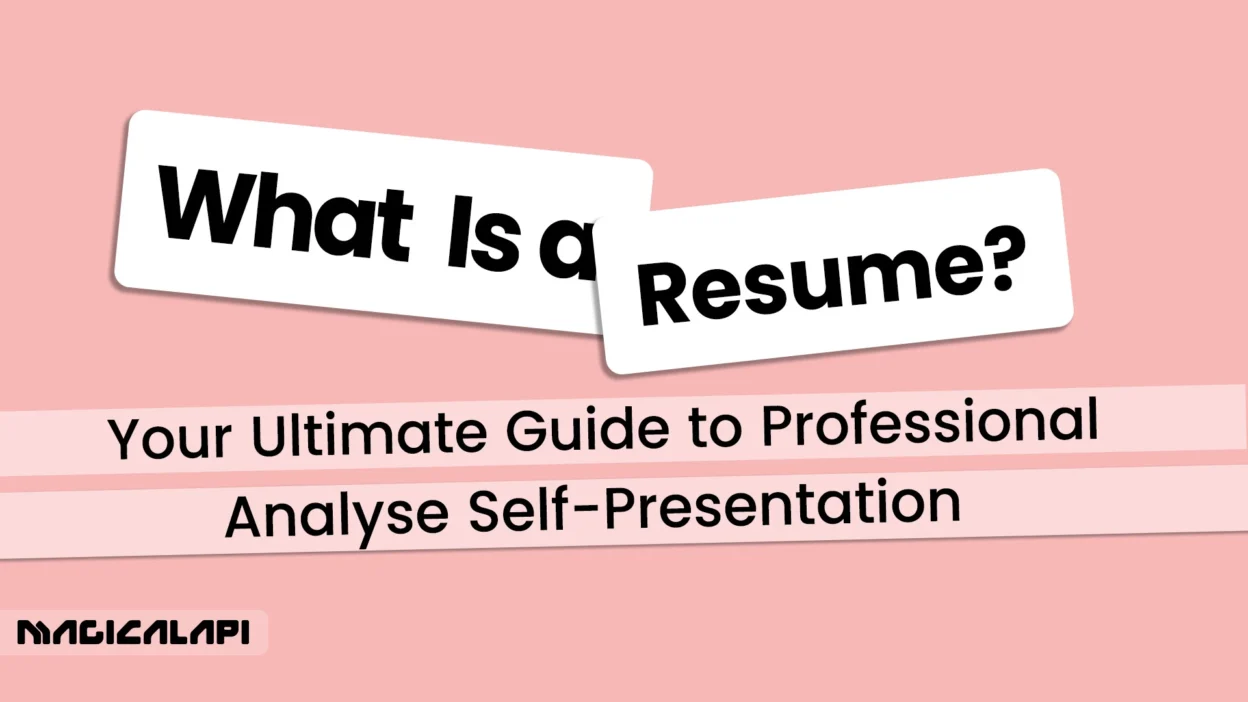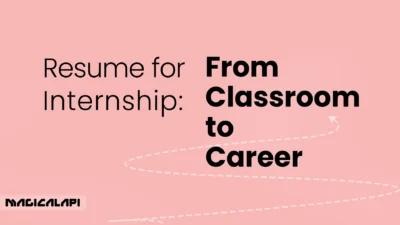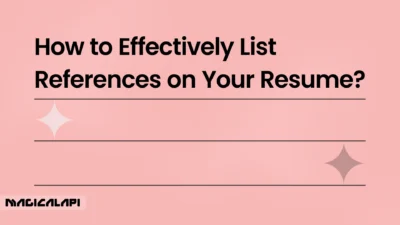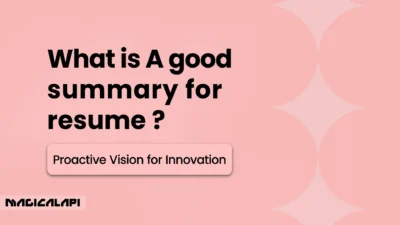What Is a Resume? Crafting a good resume is typically the first step toward landing your dream job. Whether you’re entering the workforce for the first time or preparing for a career change, your resume is your professional introduction; a way of showcasing your abilities, experience, and potential. But first thing that come to one’s mind might be: What Is a resume?
In this guide, we will cover everything you need to know about resumes, from their purpose and the definition of a professional resume to their format and templates.
Table of Contents
What Is a Resume?
What Is a Resume? A resume is a formal document that declares your qualifications for a specific job. Think of it as a quick review of your professional life, meant to inform potential employers in a quick manner about your skills, education, and experience. A CV (Curriculum Vitae) is typically longer and more detailed, while a resume is concise and targeted to a particular job or field.
The final goal of a resume is to get an interview. Companies sift through resumes to shortlist candidates for the job specifications. What Is a Resume? A good resume isn’t all about the facts—it’s about telling your story and differentiating you.
Why Is a Resume Important?
After you have answered the question: “What is a resume?” you might want to see what is the importance of a resume. Well, it is your first impression. Your resume speaks on your behalf before you physically meet the employers. Here is the reason why it matters:
- Demonstrates professionalism: A quality resume signals to prospective employers that you are professional in the application process.
- Highlights relevant qualifications: It enables you to emphasize the skills and experience that best qualify you for the job.
- Serves as a self-marketing tool: Your resume is your sales pitch, convincing employers why you’re worth hiring.
Without a strong resume, your application might get lost in the shuffle, regardless of your actual qualifications.
Read More: How To List References On Resume?
What Is the Purpose of a Resume?
The role of a resume is more than simply listing your work experience. It’s an instrument to:
- Land an interview: Your resume should arrest the attention of the reader and encourage employers to be eager to learn more.
- Highlight your value: Highlight what you have to offer and how you can assist the company to succeed.
- Personalize your presentation: Each resume can be adapted to meet the specific needs of a profession or company.
Remember, your resume isn’t just a record of your past, it’s a statement about your future potential. for checking your resume and ats friendly check Resume Checker page.
Magical Resume Checker
Discover the full potential of the Magical Resume Checker and explore the various options available to enhance your resume, optimize it for applicant tracking systems (ATS), and improve your chances of landing your dream job.
Who Needs a Resume?
The short answer: There isn’t anyone who doesn’t need one. Whether you’re entering the job market for the first time or whether you’re a professional, a resume is an important tool. Here are some scenarios where a resume is a must:
- Job candidates: For application for any professional job.
- Freelancers: To showcase past projects and clients.
- Students and new graduates: To highlight internships, coursework, and volunteer work.
- Career changers: To demonstrate transferable skills and pertinent achievements.
Regardless of which stage of your career, a properly written resume can spell doors opening.
Resume Types
There are several types of resumes, each suited to different circumstances. Choosing the right one depends on your career history and goals.
1. Chronological Resume
A chronological resume prioritizes work experience the most. It is best for individuals with stable careers who want to highlight stable growth and progression in their fields. It lists jobs in reverse chronological order, with achievements and responsibilities. With your career trajectory mapped out in a linear fashion, it is appealing to hiring managers who want stability and experience.
2. Functional Resume
A functional resume emphasizes skills and qualifications rather than work history. This resume is ideal for career changers or those with gaps in employment. Skills are categorized under general headings, and minimal emphasis is placed on actual job titles or dates. By accentuating transferable skills, this resume makes it easy to see your qualifications for a new job or industry.
3. Combination Resume
A combination resume is a middle ground between work history and skills. It is best for seasoned professionals with a skill set of many sides. The format takes elements from chronological and functional resumes, allowing you to showcase significant accomplishments while still keeping a full work history. It offers versatility and breadth, and it is best for professionals with intricate career backgrounds.
4. Targeted Resume
A targeted resume is directed at a particular job or career. Each section is tailored to bring the most suitable skills and experiences to the forefront, closely aligning with the employer’s requirements. This approach enhances your chances of landing an interview by showing only the most relevant qualifications, making a solid case for your suitability for the job.
Read more: Details on Professional Nursing Resume
What Does a Resume Include?
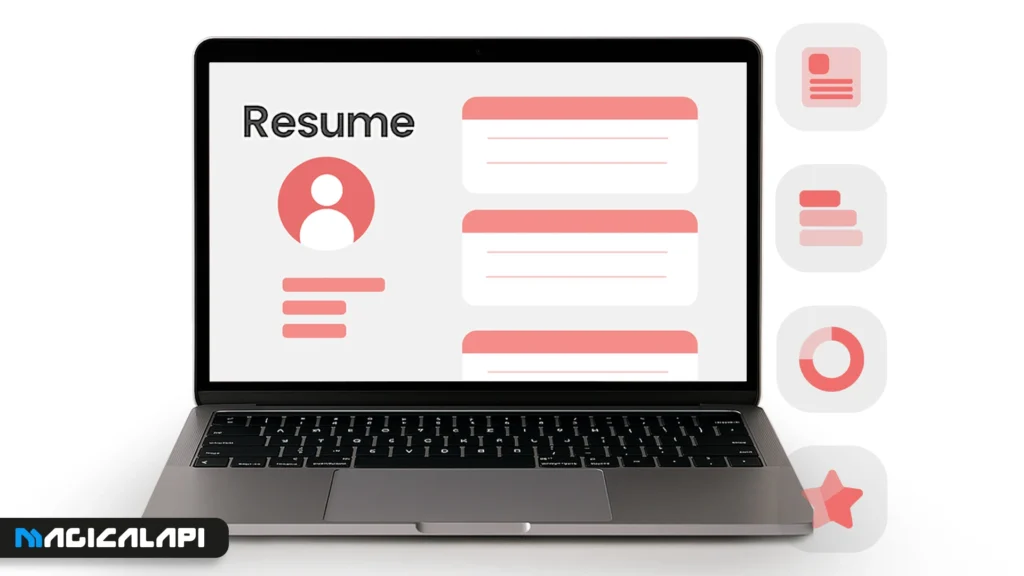
An expert resume has a few important sections. Here’s how it breaks down:
1- Contact Information
Your contact information is what employers see first, so it must be snappy and accurate. Include:
- Full name
- Phone number
- Professional email address
- LinkedIn page or portfolio URL (if any)
- Location (city and state/country)
2- Professional Summary
What is A Good Summary for Resume? A Good Summary for Resume is a brief rundown of your qualifications and career objectives. It needs to:
- Highlight your key skills and experiences
- Align with the job you’re applying for
- Be concise (2-3 sentences)
For example: “Results-driven digital marketer with 5+ years of experience enhancing brand presence through innovative strategies. Skilled in social media management, content creation, and performance analytics. Seeking to drive growth as part of a forward-thinking team.”
3- Education
Include your academic background, starting with the most recent degree or certification. List:
Institution name
- Degree and field of study
- Graduation year (optional if you’re an experienced professional)
If you don’t have much work experience, you can also highlight related coursework, awards, or extracurricular activities.
4- Work Experience
This is the hub of most resumes. For each job, include:
- Job title
- Company name
- Employment dates
- Key responsibilities and achievements
Use bullets to make it simple to scan. Highlight quantifiable achievements rather than just responsibilities.
For example:Increased social media engagement by 35% by strategically planning content.
Won a campaign that resulted in 20% growth in sales within six months.
Read More; How to write a job description for a resume?
5- Skills
List hard and soft skills relevant to the job. Common categories include:
- Technical skills: Software, programming languages, tools.
- Interpersonal skills: Communication, teamwork, leadership.
- Job-specific skills: Industry expertise or certifications.
6- Optional Resume Sections
Depending on your experience and the position, you can include the following sections:
- Certifications
- List relevant professional certifications or licenses.
- Languages
- List foreign languages spoken, and the level of proficiency.
- Volunteer Work
If you have unpaid roles that demonstrate skills or values applicable to the job, make sure to highlight them.
Read More: best ats resume checker free
Resume Template
You can download free templates on websites like Canva (which we don’t recommend because some of them are not ATS friendly resume templates) but you can also make one of your own from scratch. Crafting a resume template ensures it meets your needs, Still there are tips you should know about:
Ensure that your resume is professional in appearance using a legible, clean font such as Arial, Calibri or Times New Roman. Ensure the organization of the layout with clear subheadings and headings for a clean finish. Use bullet points to enhance reading and highlight accomplishments rather than the normal tasks.
Read More: Graphic Design Resume
For an ATS-compliant layout, avoid complex layouts, tables, or graphics that would not be correctly parsed by Applicant Tracking Systems. Highlight major sections such as “Contact Information,” “Professional Summary,” and “Skills” to draw attention to important details.
Start each bullet point with strong action verbs like led, developed, increased, or implemented to emphasize impact. Leave white space to keep the design clean and easy to scan. Customize your resume for different jobs, with its course aligned with the industry or career that you are applying for.
Finally, proofread heavily to eliminate mistakes and save the resume in two or more formats, including Word and PDF, so you can tailor to meet each employer’s desire. By doing this, you’ll create a flexible resume that truly reflects your personal brand.
Conclusion for What Is a Resume
Writing an efficient resume seems like hard work to do but it’s totally worth it. Your resume is not just a document, it is the story of your professional life and a key to new opportunities. By understanding What Is a Resume? A resume is a concise document that highlights your skills, experiences, and achievements is, what is the purpose of a resume, and how to write a proper one, you make the first step towards success. As the last point, remember to tailor your resume to each job by highlighting your unique values and presenting your skills with confidence.
FAQs about What Is a Resume
What is the purpose of a resume?
The purpose of a resume is to secure an interview by showcasing your qualifications, skills, and experiences that align with a specific job.
What does a resume include?
A resume typically includes contact information, a professional summary, education, work experience, skills, and optional sections like certifications or volunteer work.
What is the difference between a CV and a resume?
A CV is a comprehensive document detailing your academic and professional history, often used in academia or research. A resume is shorter, focusing on relevant skills and experiences for a specific job.
How long should a resume be?
A resume should ideally be one page for entry-level roles and up to two pages for experienced professionals.
Do I need a resume for freelance work?
Yes, a resume can help you present your skills and past projects to potential clients.


